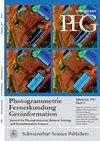DEM Generation from High Resolution Satellite Imagery
Q Social Sciences
引用次数: 19
Abstract
Digital height models (DHM) covering larger areas can be generated by means of optical or synthetic aperture radar (SAR) images taken from space. An overview of the sensors and the characteristics of generated height models is given. With very high resolution optical satellite stereo pairs a system accuracy of 1.0 ground sampling distance (GSD) standard deviation can be reached. Of course this is not the accuracy of a DEM, which is also influenced by interpolation and includes areas with limited contrast and vegetation, leading to lower quality. In addition, the difference between digital surface models (DSMs), describing the visible surface, and digital terrain models (DTMs), describing the bare ground, has to be respected. The same problem exists for SAR images used by either interferometric SAR (InSAR) or by radargrammetry if no InSAR configuration is available. It has to be ascertained whether existing regional or nearly worldwide DEMs can be used instead of especially produced elevation models. The SRTM DEM and ASTER GDEM are both available, free of charge via the Internet, but their resolution and accuracy are limited. Higher resolution DEMs, such as the SPOT DEM (also named Reference 3D) or NextMap, are not free of charge and they do not cover the whole earth. This will also be the case for the TanDEM-X height model, which will be available in 2014. If more detailed DEMs are required, they can be determined by automatic image matching of very high resolution satellite imagery.从高分辨率卫星图像生成DEM
覆盖更大区域的数字高度模型(DHM)可以通过从太空拍摄的光学或合成孔径雷达(SAR)图像生成。给出了传感器的概述和生成的高度模型的特点。在非常高分辨率的光学卫星立体对下,系统精度可达到1.0的地面采样距离(GSD)标准差。当然,这不是DEM的精度,它也受到插值的影响,包括对比度有限和植被有限的区域,导致质量较低。此外,必须尊重描述可见表面的数字表面模型(DSMs)和描述裸地的数字地形模型(dtm)之间的差异。同样的问题也存在于干涉SAR (InSAR)或雷达测量(如果没有InSAR配置)使用的SAR图像中。必须确定是否可以使用现有的区域或几乎全世界的dem来代替专门制作的高程模型。SRTM DEM和ASTER GDEM均可通过互联网免费获取,但其分辨率和精度有限。更高分辨率的DEM,如SPOT DEM(也称为Reference 3D)或NextMap,不是免费的,它们不覆盖整个地球。这也将适用于将于2014年上市的TanDEM-X高度模型。如果需要更详细的dem,可以通过非常高分辨率卫星图像的自动图像匹配来确定。
本文章由计算机程序翻译,如有差异,请以英文原文为准。
求助全文
约1分钟内获得全文
求助全文
来源期刊

Photogrammetrie Fernerkundung Geoinformation
REMOTE SENSING-IMAGING SCIENCE & PHOTOGRAPHIC TECHNOLOGY
CiteScore
1.36
自引率
0.00%
发文量
0
审稿时长
>12 weeks
 求助内容:
求助内容: 应助结果提醒方式:
应助结果提醒方式:


